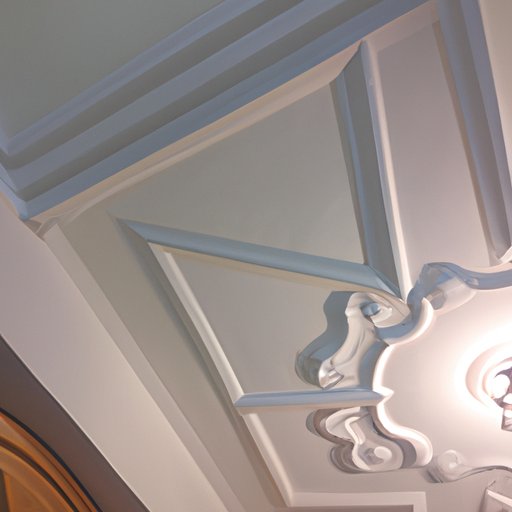Introduction
A ceiling is an upper limit or boundary. In architecture, a ceiling is the top surface of an interior room that forms the roof of a building. Ceilings can be made of many different materials including wood, plaster, metal, and drywall. They come in a variety of shapes and styles, and can be decorated with paint, wallpapers, fabric, and other treatments. This article will explore the history, benefits, types, and installation of ceilings, as well as creative ways to decorate with them.
Section 1: A History of Ceilings: From Ancient Times to Today
Ceilings have been used for centuries, dating back to ancient times. In early civilizations, ceilings were made from mud, wattle, and daub. These primitive structures provided basic shelter from the elements, but were not very durable or aesthetically pleasing. The ancient Egyptians took ceiling design to a new level of sophistication with the use of wooden beams and stone slabs. Later on, during the Renaissance period, decorative plasterwork and murals were used to embellish ceilings.
Modern advancements in ceiling design have made it possible to create ceilings with a variety of materials, textures, and styles. Pressed tin ceilings are popular in Victorian homes, while acoustic ceilings are often used in commercial buildings to reduce noise levels. Drywall ceilings are a cost-effective way to cover large areas quickly, while suspended ceilings can be used to hide pipes, ducts, and other infrastructure.

Section 2: The Benefits of Installing a Ceiling in Your Home
Installing a ceiling in your home can provide a number of benefits, including improved insulation and energy efficiency, improved soundproofing, and improved aesthetics. Insulation helps keep your home warm in the winter and cool in the summer, which can help reduce energy costs. Soundproofing helps keep noise from entering or leaving the room, making it more peaceful and comfortable. And ceilings can be decorated to match the existing décor, creating a cohesive look in any space.

Section 3: Different Types of Ceilings and Their Uses
There are several types of ceilings available for residential and commercial applications, each with its own unique characteristics and uses. Flat ceilings are the most common type of ceiling and are usually made of drywall. Textured ceilings can add visual interest to a room and can be painted or left unpainted. Vaulted ceilings create an open, airy feel, while coffered ceilings add a touch of elegance. Tray ceilings are designed with a center dip to draw attention to the center of the room.
Section 4: How to Choose the Right Ceiling for Your Room
When choosing a ceiling for your room, there are several factors to consider. First, consider your budget. Certain types of ceilings may be more expensive than others, so it’s important to determine what you can afford before making a selection. Next, assess the size and shape of the room. Certain types of ceilings work better in certain spaces, so it’s important to consider their dimensions before making a decision. Finally, choose a style that matches the existing décor. You want the ceiling to complement the existing furniture and accessories, so make sure it fits in with the rest of the room.
Section 5: The Pros and Cons of Painted vs. Unpainted Ceilings
Another factor to consider when installing a ceiling is whether to paint it or leave it unpainted. Painted ceilings can add color and texture to a room, but require regular maintenance to keep them looking fresh. Unpainted ceilings are much easier to maintain, but may not be as visually appealing as painted ceilings. Ultimately, the choice between painted and unpainted ceilings comes down to personal preference and the needs of the space.

Section 6: Creative Ways to Decorate With Ceilings
Ceilings don’t have to be boring! There are many creative ways to decorate with ceilings, from installing light fixtures to painting or stenciling designs. Wallpapers and other wall treatments are also great options for adding visual interest to a room. Another option is to hang art or fabric from the ceiling to create a dramatic effect. With the right touches, a ceiling can become a focal point in any space.
Conclusion
Ceilings can be a great way to add beauty and functionality to a room. This article has explored the history, benefits, types, and installation of ceilings, as well as creative ways to decorate with them. From flat ceilings to textured ceilings to coffered ceilings, there are many options available to suit any style and budget. With the right ceiling, you can transform any space into a beautiful, functional living area.


